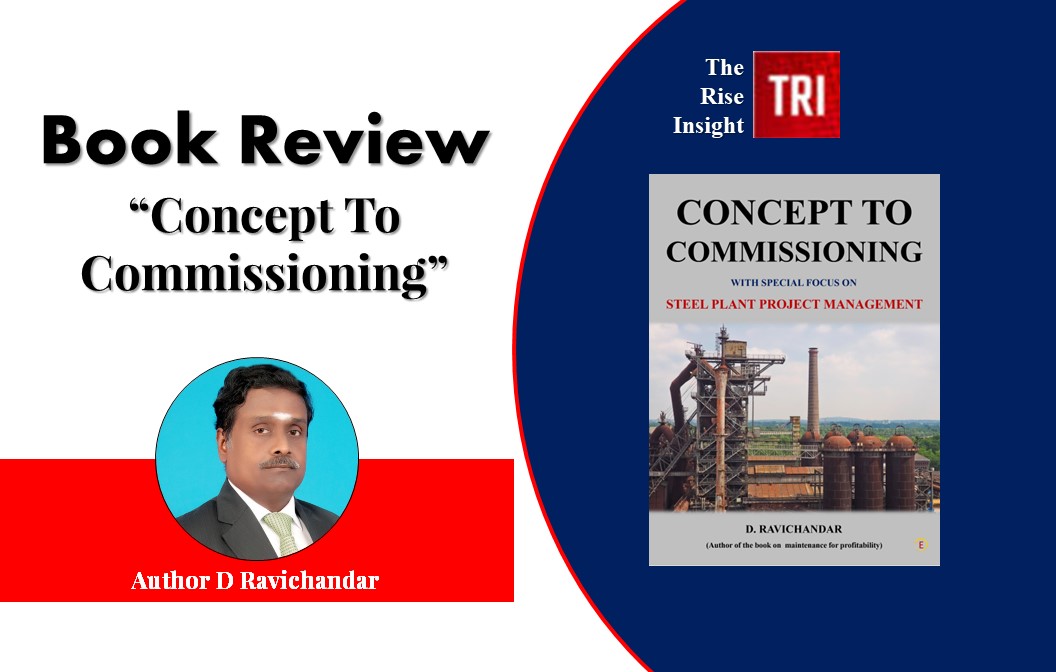Title: Concept To Commissioning
ISBN: 9789356731431
Author : D . Ravichandar
Publisher: Evincepub Publishing (2023)
Reviewed By : Tasnima Yasmin
From the author of the Book on Maintenance for Profitability comes yet another informative and interesting though highly technical read. Concept To Commissioning is a book about the author’s own life experiences working and executing the projects at hand during his tenure in various steel plants as a professional engaged in overseeing the financial and technical matters that will ensure the proper running and functioning of the steel plant, basically a role of a project manager that is quite challenging as it requires the need for both technical and management knowledge. The author combines these two skills and domains of knowledge very seamlessly not just in his career but also in this book in which he ensures that the reading experience does not becomes boring due to extremely technical vocabulary and jargon but also keeps the important technical terminologies in place to ensure that both engineering students and students of management make the most of this book. Structurally, the book is divided into 3 parts namely, Project Planning and Approval, Project Implementation and Annexures of two Case Studies and an article on Steel Processing and Futuristic Technological Developments.
The first section looks into the ideation of projects and presents a detailed market study including PESTEL and PORTER’s Five Force Analysis, Organisation SWOT analysis and action plans to ensure proper execution and fool proof running of the projects. This section is heavily technical as it expresses the product, market and demand aspects and provides an idea about financial appraisals such as creating a budget, working within and around that budget, cost of production, payback periods and internal rate of return, and other ratios required for investors. The kind of environment required is also dealt with in this section.
In the second and following section, which is about project planning, there is the explanation of systems and procedures of execution, the appropriation of various work policies and the kind of guidelines that need to be in place to ensure Risk Management, fool proof safety and standardised Quality of the final work or product is maintained. This also includes some Sections on how to Organize, schedule, procure, execute, monitor, and control the work process to ensure minimum efforts and maximum returns.
This section provides practical examples from large steel plant project executions. Another aspect that is discussed in detail in this section is called the Critical path analysis and critical path crashing. This is done through examples of executed projects of which the author has in depth knowledge and understanding. Here again, the allotted budgets, the progress made through bar charts, other progress review graphs etc., all are provided with real steel plant figures as examples. The main area of focus in this section remains on the environment in what is called the ‘large red-category’ projects. This means that alongside ethical aspects there are environmental issues that need to be kept in mind so as to maintain a proper balance in the ecology and to show that construction and technological advancement is not against the ecology but is in line with ecological development and the large scale and standardised projects of engineering are all conscious of the environment issues and want to safeguard the environment. This is highlighted through the several major and minor aspects of the public hearing that is associated with the environment issues of the projects that are also addressed to give readers a clearer picture and the larger frame.
The final and third section presents two case studies of projects that had been executed with highly challenging budgets and had time frame constraints. The author in this section cites the actual experience that he had along with his team in executing those projects. On the whole, the book also touches upon the steel-making processes and updates the readers on the latest technological development of Hydrogen usage in steel-making in India in efforts to reduce carbon dioxide emissions and to keep the environment intact. The book also provides a lot of letters of appreciation in the foreword of the book from the stalwarts in the steel industry in India that endorse the work of the author and showcase his prowess, wish him well in his endeavours and endorse his book as a pathbreaking and honest account which will be beneficial for students of engineering and management. The contents page is highly detailed. The glossary of abbreviations used is in place at the beginning of the text that is handy. Most important points in each chapter are presented in numbered points with headings in bold that allows for easy grasping of ideas. The writing style is simple though heavily technical but moderately easy to follow, interesting, highly detailed, and goes in depth into the topic and issues at hand to provide a holistic view of each project that is used as an example.
To order this book : Amazon Link


